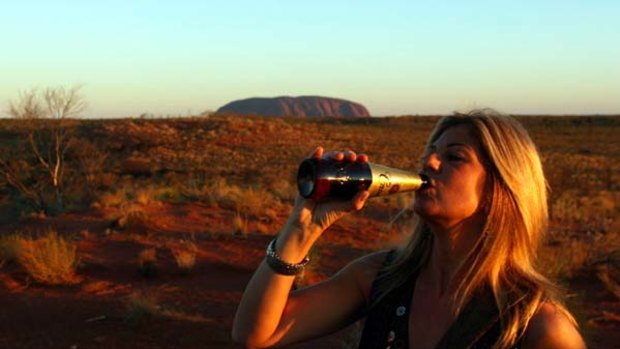By Larine Statham

After paying all the extra expenses and adhering to the rules and regulations at Uluru, perhaps tourists feel a sense of entitlement.Credit: Bryan O'Brien
I never had any real desire to visit Uluru.
I wanted to see it one day but, truth be told, it wasn't high on my list of holidaying priorities.
It's a big rock in the middle of the desert - what would I see in person that I couldn't find on a postcard?
My first visit to Uluru was for work in February this year.
As we approached the world's biggest single piece of exposed rock, also known as a monolith, I was in awe!
I finally realised why thousands of tourists flock to the rock each year.
After paying all the extra expenses and adhering to the rules and regulations, perhaps tourists feel a sense of entitlement.
A photograph could never really capture its size and magnificence - it was breathtaking!
I didn't, and still don't, entirely understand how or why people would climb the rock, knowing that the Anangu traditional owners want the route closed for good.
And what's worse is that for years people have been defecating and urinating at the top.
Surely they can hold it in long enough to get to the toilet block that is conveniently situated just opposite the base of the walk!?
I'd like to give these people a good swift kick up the behind, but I can hear my grandfather reminding me: "You can't hold what you haven't got in your hands."
How would they feel if we took a dump on the Eiffel Tower, inside the Sistine Chapel or at the Pyramids of Giza?
We'd probably be locked up!
In June it was revealed that a French woman performed and filmed a striptease on top of the rock.
Not long after, the NT News published photos of a man dancing naked at the summit and of football personality Sam Newman hitting a golf ball off the top of the rock.
"People have been climbing up that rock until the traditional owners got on to the fact that there's some mileage ... in not letting people climb," Mr Newman told a Melbourne radio station.
Some people were outraged, some thought it funny, others didn't care.
Questions were raised on the comment pages of local newspapers about whether it's the local Aborigines who object to the rock climb and the photographing of sacred sites around Uluru, or whether it was the "do-gooders hippy policy-makers on the east coast" who had forgotten that National Parks are there to be enjoyed by ALL Australians.
I stayed a few nights out at Yulara again recently, working on a story about the disappearance of nine-week-old Azaria Chamberlain 30 years ago, and have since spent a bit of time thinking about the bureaucratic red-tape that now envelopes our national parks, particularly Kata Tjuta.
I don't condone people disrespecting sacred Aboriginal sites, but maybe after paying all the extra expenses and adhering to the rules and regulations, perhaps tourists feel a sense of entitlement.
When you check-in at any of the resort or hotel facilities at Yulara, you are slogged a few dollars for the Mutitjulu Foundation, but you aren't told about the charge until you find a cardboard sign in your room thanking you for the donation to the local welfare-dependant Aboriginal community, which was built at the base of one of Australia's biggest wealth-generating tourism gold mines less than 30 years ago but today remains in a constant state of poverty and despair.
The cardboard cut-out says that if you want your money back you just have to ask at reception.
Very few tourists are able to enter Mutitjulu, but if they did they'd surely ask to be shown where the money has been spent.
Maybe the money donated by the tourists is tied up in the current furore between the federal, territory and local governments about whose responsibility it is to provide services to Mutitjulu.
Visitors to Yulara are subjected to a surcharge every time they use a credit card.
They pay $25 entry fee per person and, yet, unlike Kakadu National Park, where you can even photograph the sacred rock art sites, there are no camping sites in the park itself and there are very few walking trails.
There's a visitor centre, a viewing platform, a few toilet facilities, bitumen roads and not much else.
In the words of Steve Brown, an Alice Springs resident who wrote a letter to the editor of the Centralian Advocate - "more and more visitors are coming away ... angry at the greedy, disrespectful, meat-market approach so clearly on display".
I am one of those visitors!
AAP
Sign up for the Traveller newsletter
The latest travel news, tips and inspiration delivered to your inbox. Sign up now.